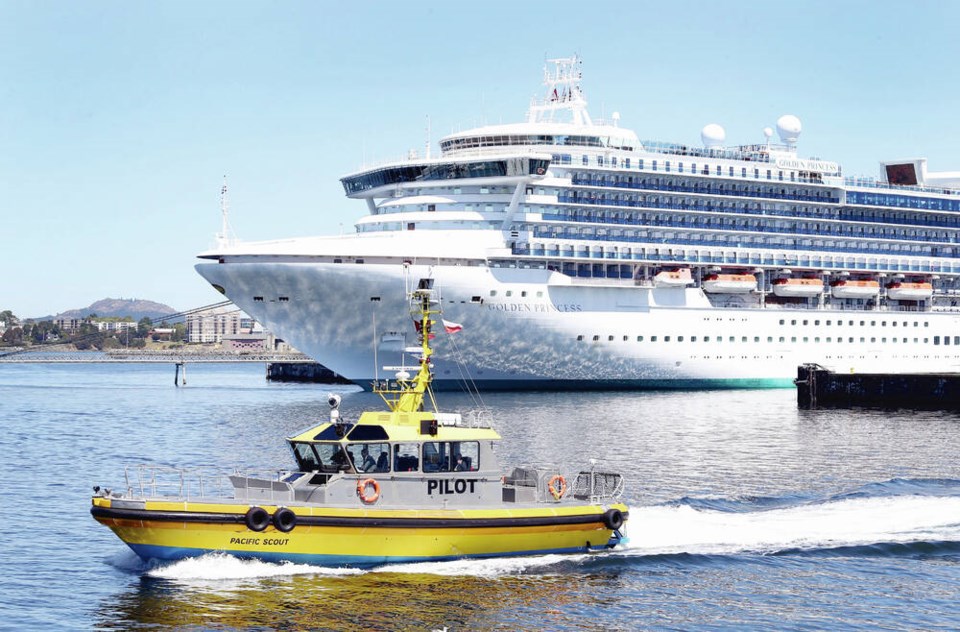A commentary by a former chief executive officer of the Greater Victoria Harbour Authority.
Victoria is at risk of losing more than half of its cruise-ship visits because of proposed changes to the U.S. Passenger Services Act.
The act was intended to protect jobs in the United States, but today, it is not protecting anything.
Those jobs were in shipbuilding, but no cruise ships have been constructed in the U.S. for decades, as well as in shipping — but if anything, the act is creating jobs in other countries.
Regulations of the act state that foreign-flagged, built and manpowered passenger ships cannot operate between U.S. ports. This means at least one foreign stop on a cruise — and American politicians are making serious efforts to end that requirement.
The Victoria market is driven by ships using Seattle as a home port, and our cruise tourism exists because of the Passenger Services Act.
The ships from Seattle do seven- or 10-day runs to Alaska, a trip that is about seeing glaciers. The ships need to make this run at high speed, which means high fuel costs.
Ships stop in Victoria on the last night of a cruise, on their way back to Seattle. They arrive in late afternoon or evening. Often they are challenged by high winds and miss the call.
If the ships did not need to stop at Victoria they could slow down and save fuel, save port call costs, and require no passport/customs clearance.
The ships do well with shore excursions in Victoria, and passenger exit ratings are high. But most passengers take the shuttle or walk downtown; no revenue for the ship. So why come to Victoria?
Victoria’s cruise tourism will be devastated if the act is revised. Only ships that are looking for an interesting port call on a longer itinerary are likely to continue calling.
It will take a few years for the industry to drop Victoria, as the planning for provisions, ship services, excursions and marketing collateral are done many years forward. But it will be dropped.
Vancouver is not a port of call; it will continue to be a home port for cruises to Alaska, because there is not enough capacity in Seattle.
Victoria will never be a home port. It does not have enough air lift capacity. It is, however, the only viable port of call in British Columbia.
Campbell River has been all but abandoned. The tides are difficult, the cost of tugs and longshore labour are high, and there are limited excursions. This terminal should never have been built.
Nanaimo has limited excursion opportunities, a poor location on the inside passage of the Island, and it is too close to Vancouver and Seattle. Nanaimo has only seen stops from ships sailing for relocations, and for a brief time a shoulder-season sailing schedule. All are gone, but there is a nice dock and a new office building.
Port Alberni has had a few calls of specialty ships, but it is a long way up the channel and requires a pilot, tugs and so on. And again, limited shore excursion capacity.
Prince Rupert is similar to Alaska destinations, so not that attractive as a special call. Shore excursion opportunities are limited.
But being the only viable port of call will not help Victoria. I project that calls will drop to less than half of current volume.
Princess and Holland America, the founders of the Alaska cruise market, will continue to be the core valued customers.
The Greater Victoria Harbour Authority invested in a pier extension to attract other lines, and they will be the first to abandon Victoria.
Changing the regulations in the Passenger Services Act would apply to all American cruise ports, but the most extreme impact would be in Victoria.
Ships could sail freely from Seattle to Alaska, with some running from San Francisco to Alaska. They could sail from Los Angeles and San Diego to Hawaii.
The market is much smaller on the East Coast. Ships sailing out of New York and Boston are mostly cruising for the fall colours along the St. Lawrence River. Changing the act might not have a significant impact as Canada’s fall spectacular leaf display is the destination/ purpose of the cruise.
The Florida homeport market is the most critical market in the U.S., followed by Los Angeles and San Diego. All of these ships sail to southern waters, Mexico and the Caribbean, and nothing is likely to change.
The U.S. cruise industry is not standing up and arguing to keep this law. In Canada, the national impact is not significant, so it is not high on the federal issues agenda.
As it is an internal issue for the U.S., outside lobbying by a relatively small industry will have little impact. It will just let a few folks look like they are doing something.
The harbour authority, a non-profit society, has a master plan that would rely on cruise tourism revenue to fuel development.
It needs to accept that new reality of much-reduced cruise tourism. That would be better than trying for increased call numbers that would bring alleged economic benefits for a select few tourism operators at the expense of Victoria’s environment.
The new reality might be a preferred future.



